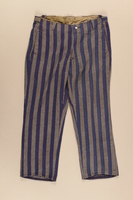Overview
- Brief Narrative
- Blue and gray striped uniform jacket with a prisoner number and red triangle of the type worn by concentration camp prisoners during the Holocaust. By 1937, blue and gray prisoner uniforms had become standard issue in the Nazi concentration camp system. Generally, new prisoners were separated into two groups: men, and then women and children. The prisoners then had their hair shorn, were deloused and issued a uniform. Some prisoners received old uniforms worn by previously killed inmates. Men received a cap, pants, and a jacket, while women received a dress or skirt with a jacket and kerchief for their head. Prisoners received an identification number, which was often paired with a color coded triangular badge: yellow for Jews, red for political prisoners, green for criminals, black for asocials or Gypsies, pink for homosexuals, and purple for Jehovah’s Witnesses. These were worn on the left side of the chest or on the left sleeve, and occasionally on the right side of the pants. Most uniforms were made in workshops of some of the larger camps such as Dachau, Sachsenhausen, and Ravensbrück. The uniforms were made in different sizes, but were not assigned according to size, so many were altered to improve fit. Newly issued uniforms were often shortened or lengthened at the hems or widened with inserts. As prisoners’ physical condition deteriorated in the camps, they moved buttons or took in seams to compensate for malnourishment. Some uniforms, especially those of higher ranking prisoners such as Kapos, had pockets. Others had pockets secretly sewn into them, which allowed them to hide extra rations or useful items. After the war, many badges were removed from uniforms. Abandoned uniforms were often crudely patched and repaired with fragments from other uniforms.
- Date
-
1937-1945 May
- Geography
-
creation:
Europe
- Credit Line
- United States Holocaust Memorial Museum Collection
Physical Details
- Classification
-
Clothing and Dress
- Category
-
Concentration camp uniforms
- Object Type
-
Jackets (lcsh)
- Genre/Form
- Prison uniforms.
- Physical Description
- Blue and gray, vertically striped, hip-length, long-sleeved, mediumweight, plain weave cloth jacket. The blue stripes are printed on both sides of the gray cloth, and the seams are machine stitched with gray thread. The thick, reinforced collar has pointed ends with rounded tips and is fastened with a black metal hook and eye closure. The front placket has five circular, thick, black plastic buttons stitched to the right side with off-white thread. There are five corresponding, finished, horizontal buttonholes along the left side. A rectangular, discolored white cloth patch is hand sewn to the left breast. Stenciled in black ink on the left side of the patch is a six-digit prisoner number. The ink has run on the cloth, creating a black, hazy area around the numbers. To the right is an inverted red triangle with a wax-like coating on the surface, sewn on with black thread. There are three slash pockets on the jacket: a small one above the patch, and one on each hip. The edges of the pockets are lined with blue cloth. On the interior of the jacket, a gray cloth hanging loop is sewn to the collar, and there are bound seams at the armholes. On the right hip, there are two small holes in the cloth.
- Dimensions
- overall: Height: 23.000 inches (58.42 cm) | Width: 15.375 inches (39.053 cm)
- Materials
- overall : cotton, thread, plastic, metal, ink
- Inscription
- front, left breast, on patch, stenciled, black ink : 31639
Rights & Restrictions
- Conditions on Access
- No restrictions on access
- Conditions on Use
- No restrictions on use
Keywords & Subjects
Administrative Notes
- Legal Status
- Permanent Collection
- Provenance
- The jacket was acquired by the United States Holocaust Memorial Museum in 1997.
- Record last modified:
- 2022-07-28 18:23:31
- This page:
- https://collections.ushmm.org/search/catalog/irn12196
Download & Licensing
In-Person Research
- By Appointment
- Request 21 Days in Advance of Visit
- Plan a Research Visit
- Request to See This Object
Contact Us
Also in Concentration camp uniform jacket and pants collection
The collection consists of a concentration camp uniform jacket and pants.
Date: 1937-1945

Concentration camp inmate uniform pants
Object
Blue and gray striped uniform pants of the type worn by concentration camp prisoners during the Holocaust. By 1937, blue and gray prisoner uniforms had become standard issue in the Nazi concentration camp system. Generally, new prisoners were separated into two groups: men, and then women and children. The prisoners then had their hair shorn, were deloused and issued a uniform. Some prisoners received old uniforms worn by previously killed inmates. Men received a cap, pants, and a jacket, while women received a dress or skirt with a jacket and kerchief for their head. Prisoners received an identification number, which was often paired with a color coded triangular badge: yellow for Jews, red for political prisoners, green for criminals, black for asocials or Gypsies, pink for homosexuals, and purple for Jehovah’s Witnesses. These were worn on the left side of the chest or on the left sleeve, and occasionally on the right side of the pants. Most uniforms were made in workshops of some of the larger camps such as Dachau, Sachsenhausen, and Ravensbrück. The uniforms were made in different sizes, but were not assigned according to size, so many were altered to improve fit. Newly issued uniforms were often shortened or lengthened at the hems or widened with inserts. As prisoners’ physical condition deteriorated in the camps, they moved buttons or took in seams to compensate for malnourishment. Some uniforms, especially those of higher ranking prisoners such as Kapos, had pockets. Others had pockets secretly sewn into them, which allowed them to hide extra rations or useful items. After the war, many badges were removed from uniforms. Abandoned uniforms were often crudely patched and repaired with fragments from other uniforms.



